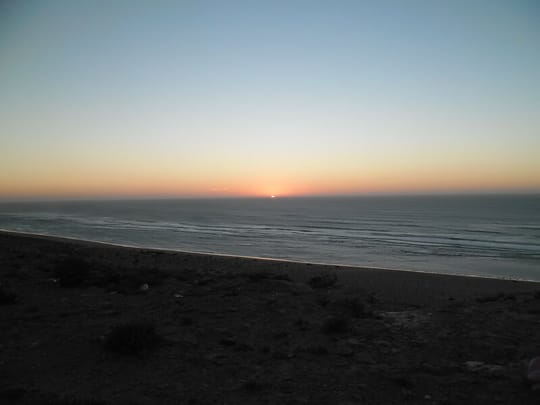Sunday, December 16, 2012: Trip to Thuqb Jrifia, Aftisaat Cap 7 (Rural village of fishermen) and Awziwalt Beach.
Hanna and her husband packed everything required for the trip. We departed from Boujdour city at 9:30 am and took the national road that leads to Dakhla. After driving for two hours and a half, we left the coast on the right, crossed the national road and took the asphalted road on the left. We drove about 30 km towards the desert. It took us three hours to arrive to a place where we have a picnic. It was a very long way. It was 12:30pm, we didn’t manage to go to the bottom of the desert, Mercedes cars can’t go inside, thus we halted at the end of the asphalt by stopping a car next to acacia tree, called “Taleh” in Arabic.
We rested under the tree with some blankets to sit on. Si Baderi and Sidi Mohamed gathered some firewood to set up a fire for cooking and making tea. Hanna was preparing lunch using a big cooking pot called “Al marjen”. We had “zrig” then tea together. I was taking pictures of some insects and plants growing there; there were “zizwane” ( a grey white spotted beetle makes load noise especially in summer) and “khanfussa” (a very dark dang beetle) and a plant with watery leaves used for washing hands or cloths in the earlier times called “ghassul” (see pictures).
On our way back to Aftisaat Cap7 and Awziwalt beach, we came across “lfriig” (a group of three or more tents). There were some tents set in the middle of “grarat” (pastures with green plants and herbs). It was a long distance to Aftisaat Cap 7; it is a rural village situated in the coast where fishermen reside and work. Above of the seashore, there is a construction area that consists of housing and some facilities built by the Moroccan State to be offered to the fishermen when they are complete. We looked down below and saw a large cluster of slums and some anchored small blue boats “flukat” next to the blue sea. No woman or child was there, only some young boys playing football in the beach. We took pictures and drove away towards Awziwalt beach; it is a very long large clean sandy beach. It was completely vacant except for an empty room and a white building which is a shrine of “Saleh” (a saint) belong to the tribe of Elaaroussiin. Sidi Mohammed, Hanna’s husband, was proud to talk about that shrine and his ancestors Elaaroussiin who had built that room for anyone who comes to visit the shrine. Now, however, it is damaged by poor fishermen, drunkards and illegal immigrants to Las Palmas.
Though we didn’t stay long in that beach, I enjoyed the sunset kissing the grey bluish sea and the beautiful plants we saw while in Awziwalt beach.
This trip was positive in the sense that it gave me a concrete view of the rural area of Boujdour province and its communities to develop my coming work plan. I heard people talking about Aftisaat and Jrifia, but seeing things in reality is more workable than just hearing about them.
December 17, 2012
The HAF’s community meeting was canceled by the local authority, who asked me to create a local branch of HAF before authorizing any further community meetings. I was so sad about that cancelation, especially since nearly 40 people attended that day and they had a strong will to have a training about participatory planning. However, I saw that in their eyes and their text messages to me asking to coordinate with them future dates that they are determined to participate.
